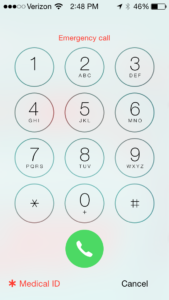Creating Tech Free Space in Your Home
Sometimes I feel like no matter where I go in my house, someone, or everyone, is lock into a screen of some sort. One child is in his room on social media on his iPad. Another is in the family room playing XBOX. My husband is in the office working on his laptop. It can be maddening at times. But the one place I know that I can go and not find any phones, iPads, laptops or televisions is my kitchen island. In our house, the kitchen island is known as a ‘tech free zone’.
In an effort to incorporate healthy tech in the home, try creating tech free zones in the house. It is simple to do and can also be a component of your ‘digital road map‘ that you may have previously created. To do this, all you need to do is answer one question: In what part of the house, do we want to NEVER have technology? It can be bedrooms. It can be the TV room or family room. For us, it is the island in the kitchen. Certainly we are watchful about technology in the bedrooms, but for my family and for a variety of reasons, bedrooms are not official ‘tech free zones’. The island is the place where we truly gather as a family. We eat most family meals here. The kids eat breakfast here. We play games at the island. We have the debrief of the day here as my kids eat a snack or dessert. It is where conversation happens. There are very few distractions and it has become a part of our family culture.
Here is the catch to making a tech free zone a success in your home: EVERYONE has to follow the rules! This means that my husband and myself are tech free at the island. When we gather for dinner, my phone gets left in another room. When I am hanging out with my son, hearing about his cross country practice as he eats ice cream, if my phone vibrates with a call or text, I resist the urge to pick it up or pull it out of my back pocket. If I do, I am quickly reprimanded, and rightly so, by whomever I am sitting with at the island. My kids buy into this program for two reasons. First, I think they enjoy this small amount of the day being unplugged. Second, I think they very much enjoy having my or my husband’s undivided attention. Really, they should have that all the time. Sadly, given the times we live in, it doesn’t always happen.
There are some great upsides to creating a tech free zone in the home in addition to the obvious of quality time together. One of the greatest of these upsides is that it significantly reduces conflict around phones, ipads, etc. For my family, the kids just do not bring tech to the island. It is not something that needs to be reminded or argued about. Because we all abide by this rule all the time, it has become a way of life. It is so nice not to begin dinner with comments like ‘please stop texting’ or ‘put your phone away’. It is so nice not to hear the beeping and pinging of the various alerts from my kids phones. It is so nice to have conversation where my kids not only participate but where I actually get to see their beautiful faces vs. the tops of their heads as they look down at a phone.
Another upside is that kids start to get conditioned to the idea of tech free zones and associate it with the activity that happens in that space. For my kids, they associate meals, in general, as a time for conversation, not tech and it starts to move beyond the home. When we are at family parties, I sometimes hear the comment that a cousin was texting all through dinner. It is expressed with a sense of disappointment at the lost opportunity to hang out.
In the interest of full disclosure, my children are very normal teenagers with their phones. There are many times I find myself looking at the tops of their heads or feeling like I am in battle for their intention and the little rectangular box they are holding in their hands is winning the war. However, for 30 minutes a day, there is a cease fire in the war because the kitchen island is a neutral, or tech free zone.



